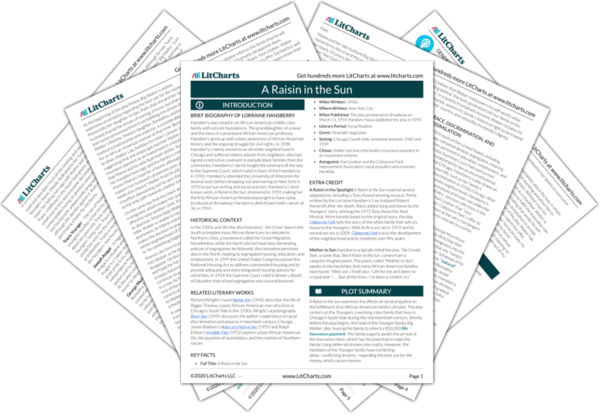Welcome to the LitCharts study guide on Lorraine Hansberry's A Raisin in the Sun. Created by the original team behind SparkNotes, LitCharts are the world's best literature guides.
A Raisin in the Sun: Introduction
A Raisin in the Sun: Plot Summary
A Raisin in the Sun: Detailed Summary & Analysis
A Raisin in the Sun: Themes
A Raisin in the Sun: Quotes
A Raisin in the Sun: Characters
A Raisin in the Sun: Symbols
A Raisin in the Sun: Theme Wheel
Brief Biography of Lorraine Hansberry

Historical Context of A Raisin in the Sun
Other Books Related to A Raisin in the Sun
- Full Title: A Raisin in the Sun
- When Written: 1950s
- Where Written: New York City
- When Published: The play premiered on Broadway on March 11, 1959. Random House published the play in 1959.
- Literary Period: Social Realism
- Genre: Dramatic stage play
- Setting: Chicago’s South Side, sometime between 1945 and 1959
- Climax: Walter Lee loses the family’s insurance payment in an investment scheme.
- Antagonist: Karl Lindner and the Clybourne Park Improvement Association; racial prejudice and economic hardship
Extra Credit for A Raisin in the Sun
A Raisin in the Spotlight A Raisin in the Sun inspired several adaptations, including a Tony Award-winning musical. Partly written by the Lorraine Hansberry’s ex-husband Robert Nemiroff, after her death, Raisin added song and dance to the Youngers’ story, winning the 1973 Tony Award for Best Musical. More loosely based on the original story, the play Clybourne Park tells the story of the white family that sells its house to the Youngers. With its first act set in 1959 and its second act set in 2009, Clybourne Park tracks the development of the neighborhood and its residents over fifty years.
Mother to Son Hansberry originally titled the play, The Crystal Stair, a name that, like A Raisin in the Sun, comes from a Langston Hughes poem. The poem, called “Mother to Son,” speaks to the hardships that many African-American families have faced: “Well, son, I’ll tell you: / Life for me ain’t been no crystal stair / . . . But all the time / I’se been a-climbin’ on.”












